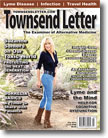|
Aluminum and Glyphosate
There is growing awareness of the increasing environmental exposure of aluminum and glyphosate, the active ingredient in the herbicide Roundup.
We have been tracking both of these toxicants in our patients and use several treatment strategies to decrease the body burden of both of these harmful substances.
Dr. Stephanie Seneff first opened our eyes to the biological impact of glyphosate. Her recent paper "Aluminum and Glyphosate Can Synergistically Induce Pineal Gland Pathology: Connection to Gut Dysbiosis and Neurological Disease" demonstrates the synergy of aluminum and glyphosate.1
In summary, through several mechanisms glyphosate increases the uptake of aluminum in the gut while blocking the uptake of a variety of needed trace minerals. The increased body burden of aluminum damages the pineal gland. Both aluminum and glyphosate disrupt the CYP450 enzymes, which have a role in melatonin production. In addition, glyphosate disrupts the production of tryptophan – a precursor to melatonin – by our beneficial bowel microbes. Both toxicants impair the body's production of melatonin. We just reviewed how sleep is imperative for the glymphatic system. Disrupted melatonin production directly impairs the brain's ability to detoxify.
It is difficult to demonstrate the body burden of aluminum using a traditional urine challenge test. Aluminum is firmly bound to tissue proteins and very hard to mobilize with any type of challenge test. We recently started using the OligoScan, a device that uses a technology called spectrophotometry to determine tissue trace element and heavy metal levels. The majority of our patients have overwhelmingly elevated aluminum. Aluminum is today the most prevalent toxic metal in our patients – ahead of lead, mercury, nickel, and tin.
It is also challenging to demonstrate the body burden of glyphosate. We look at PON1 gene status and exposure history to determine necessity of treatment. We support PON1 epigenetically with antioxidants such as açai, pomegranate, vitamin C, selenium, and vitamin E. We also use low-dose immunotherapy to facilitate the removal of glyphosate and other herbicides that typically are in the same cocktail. When we split-sampled patients' urine in the past, typically the US labs did not find any glyphosate, while the German labs found significantly elevated levels in the same urine. A new US-based urine glyphosate test is now available that we do not have clinical experience with yet.
Our current aluminum detoxification strategies include silica-based products. We commonly use liposomal silica, horsetail, and a silica-based binder called Enterosgel to decrease aluminum in our patients. The US-trained neurologist Margaritha Griess-Brisson (living in the UK) found that a cilantro tincture given 3 times per day combined with an ionic footbath used twice weekly increased the elimination of all toxic metals, especially the excretion of aluminum. Y. Omura, MD, also found that cilantro was effective in removing lead, mercury, and aluminum (study on mice).
Case Study: 28-year-old female, chronic fatigue, constipation, nausea, head pain, pressure .pdf
Case Study
J.F. was an 8-year-old autistic boy who was mute. He had been through the biomedical approach for years and had improved largely. What was not addressed in his treatment was the intrauterine exposure to Lyme and glyphosate and the early exposure to aluminum (ambient air, vaccines) and ethylmercury. We added the strategies for these issues, included LDI treatment for mercury, Lyme, glyphosate, and aluminum. After a few initial crises, he started to make one-syllable words; within a few weeks, two-syllable words; and after 9 months (of the added treatment), he was completely age-appropriately fluent in English and near neurotypical.
Conclusion
Microbes evolve, toxins used in our environment have changed – and exposures to them, and with them illnesses evolve. What we see today in our medical offices is almost completely different from what Dr. Klinghardt saw when he started seeing patients 41 years ago. Lab methods are often hopelessly behind the times and we, the frontline physicians, have often to rely on other tools to help diagnose our clients. The current plague of Lyme disease, retroviral infections, and environmental toxins affecting us were not discovered in a university lab. These most pressing issues were discovered by us, the people. In this article, we point toward several illness-causing issues that are relevant to almost every person we see in the office. In a future article, we may highlight the other big one: exposure to microwaves and adverse electromagnetic fields and what we can do about it. When we know what is underneath our illnesses and causing them, we can still protect and heal others and ourselves and have fulfilling, joyful lives.
Notes
1. Seneff S, Swanson N, Li C. Aluminum and glyphosate can synergistically induce pineal gland pathology: connection to gut dysbiosis and neurological disease. Agric Sci. 2015;6:42–70.
 Dietrich Klinghardt, MD, PhD, was born, raised and educated in West Germany, where he graduated from Freiburg Medical School/Albert Ludwigs University in 1975. He also studied psychology and completed a 3-year research project/PhD in angiology. He is internationally known for his successful treatment of chronic pain and illness. Dr. Klinghardt combines nonsurgical orthopedic medicine with immunology, endocrinology, toxicology, neural therapy, hypnotherapy, and energy psychology. He has been in practice for over 40 years and has been a pioneer in the diagnosis and treatment of Lyme disease, applying his 5 Levels of Healing model. Dr. Klinghardt founded Sophia Health Institute in Woodinville, Washington, where he sees patients. Dietrich Klinghardt, MD, PhD, was born, raised and educated in West Germany, where he graduated from Freiburg Medical School/Albert Ludwigs University in 1975. He also studied psychology and completed a 3-year research project/PhD in angiology. He is internationally known for his successful treatment of chronic pain and illness. Dr. Klinghardt combines nonsurgical orthopedic medicine with immunology, endocrinology, toxicology, neural therapy, hypnotherapy, and energy psychology. He has been in practice for over 40 years and has been a pioneer in the diagnosis and treatment of Lyme disease, applying his 5 Levels of Healing model. Dr. Klinghardt founded Sophia Health Institute in Woodinville, Washington, where he sees patients.

Dr. Christine Schaffner is a board-certified naturopathic physician who graduated from Bastyr University. She completed her undergraduate studies in pre-medicine and psychology at the University of Virginia in Charlottesville, Virginia. Dr. Schaffner specializes in the treatment of chronic illness and is the clinic director of Sophia Health Institute in Woodinville, Washington.
Page 1, 2 |
![]()
![]()
![]()





 Dietrich Klinghardt, MD, PhD, was born, raised and educated in West Germany, where he graduated from Freiburg Medical School/Albert Ludwigs University in 1975. He also studied psychology and completed a 3-year research project/PhD in angiology. He is internationally known for his successful treatment of chronic pain and illness. Dr. Klinghardt combines nonsurgical orthopedic medicine with immunology, endocrinology, toxicology, neural therapy, hypnotherapy, and energy psychology. He has been in practice for over 40 years and has been a pioneer in the diagnosis and treatment of Lyme disease, applying his 5 Levels of Healing model. Dr. Klinghardt founded Sophia Health Institute in Woodinville, Washington, where he sees patients.
Dietrich Klinghardt, MD, PhD, was born, raised and educated in West Germany, where he graduated from Freiburg Medical School/Albert Ludwigs University in 1975. He also studied psychology and completed a 3-year research project/PhD in angiology. He is internationally known for his successful treatment of chronic pain and illness. Dr. Klinghardt combines nonsurgical orthopedic medicine with immunology, endocrinology, toxicology, neural therapy, hypnotherapy, and energy psychology. He has been in practice for over 40 years and has been a pioneer in the diagnosis and treatment of Lyme disease, applying his 5 Levels of Healing model. Dr. Klinghardt founded Sophia Health Institute in Woodinville, Washington, where he sees patients.